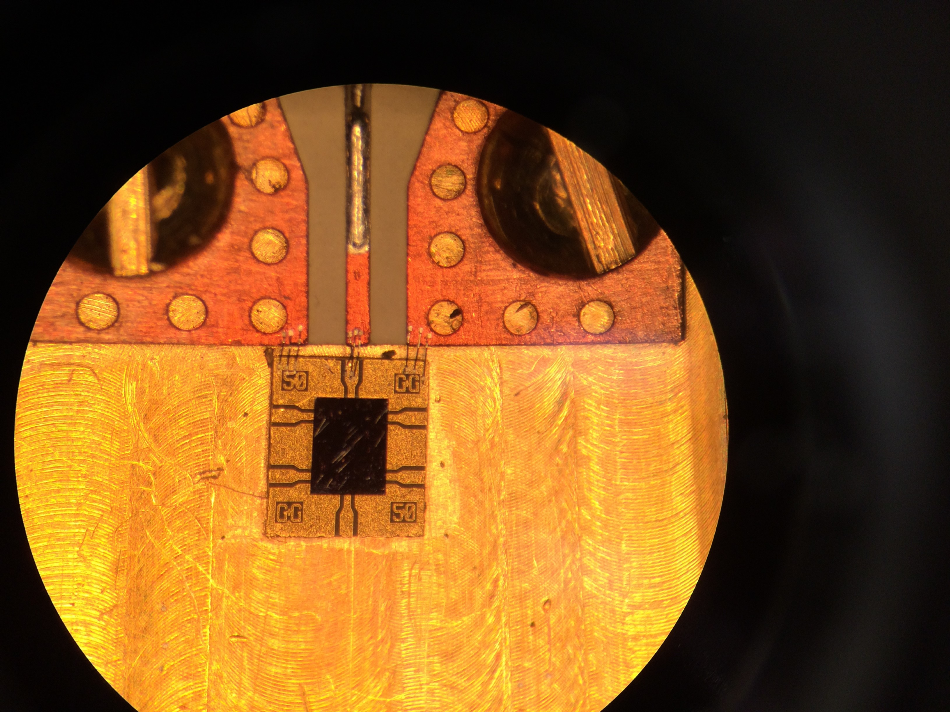May 22 2020
At the National Institute of Standards and Technology (NIST), scientists have employed sophisticated light detectors, next-generation atomic clocks, and a measurement tool known as a frequency comb to increase the stability of microwave signals by 100 times.
 The black rectangle (center) is a high-speed, semiconductor photodiode that converts laser pulses to super-stable microwave frequencies. The diode is surrounded by a gold-coated border in which electrical leads are embedded. Wires connect the leads to the copper electrical circuit (top) used to extract microwave signals. The entire set-up rests on a brass plate for mechanical stability. Image Credit: F. Quinlan/National Institute of Standards and Technology.
The black rectangle (center) is a high-speed, semiconductor photodiode that converts laser pulses to super-stable microwave frequencies. The diode is surrounded by a gold-coated border in which electrical leads are embedded. Wires connect the leads to the copper electrical circuit (top) used to extract microwave signals. The entire set-up rests on a brass plate for mechanical stability. Image Credit: F. Quinlan/National Institute of Standards and Technology.
This represents a major step toward more improved electronics to facilitate more precise time dissemination, more reliable communications, enhanced navigation, and higher-resolution imaging for astronomy and radar. Reliable operation of a system or device can be ensured by enhancing the consistency of the microwave signal across a particular period of time.
Through this work, the already excellent stability of the advanced laboratory atomic clocks working at optical frequencies is transferred to microwave frequencies; presently, microwave frequencies are used for calibrating electronics.
Since optical signals cannot be directly counted by electronic systems, the techniques and technology developed by NIST indirectly convey the signal stability of these optical clocks to the microwave domain. This demonstration has been detailed in the Science journal in the May 22nd, 2020, issue.
In their experimental setup, the scientists generated light pulses by using the “ticking” of a pair of NIST’s ytterbium lattice clocks. They also used frequency combs that act as gears to accurately convert the higher-frequency optical pulses into lower-frequency microwave signals.
Light pulses are converted into electrical currents through sophisticated photodiodes. These electrical currents consequently produced a 10 GHz, or a billion cycles for each second, microwave signal that precisely monitored the ticking of the clocks, with an error of only one part in a quintillion—that is, 1 followed by 18 zeros.
This level of performance not only corresponds with that of both optical clocks but also 100 times more stable than the most optimal microwave sources.
Years of research, including important contributions from NIST, have resulted in high-speed photodetectors that can now transfer optical clock stability to the microwave domain. The second major technical improvement was in the direct tracking of the microwaves with high precision, combined with lots of know-how in signal amplification.
Frank Quinlan, Lead Researcher, National Institute of Standards and Technology
Compared to microwaves, optical waves have faster and shorter cycles and, hence, they have varying shapes. While changing the stable optical waves into microwaves, the scientists monitored the phase—that is, the precise timing of the waves—to make sure that they were identical and not moved in relation to each other. During the experiment, the phase changes were tracked with a resolution that corresponds to only one-millionth of a cycle.
This is a field where just doubling microwave stability can take years or decades to achieve. A hundred times better is almost unfathomable.
Chris Oates, Group Leader, National Institute of Standards and Technology
According to Quinlan, a few components of the NIST system, like the detectors and frequency combs, are currently set to be employed in field applications. However, the NIST team is still working on changing the advanced optical clocks into mobile platforms. Working at frequencies of 518 THz (that is, trillion cycles per second), the ytterbium clocks now occupy bulk tables in highly regulated laboratory settings.
Ultra-stable electronic signals can potentially support extensive applications, including upcoming calibration of electronic clocks, like electric devices driven by oscillating quartz crystals. This happens to be a major consideration for redefining the SI second—the international time standard—currently based on the microwave frequencies captured by the cesium atoms present in traditional clocks.
In the days to come, it is believed that the international scientific community will choose a new time standard on the basis of optical frequencies that are absorbed by other atoms, like ytterbium. Wireless communications systems could be made more reliable through super-stable signals.
Imaging systems could be made more sensitive by optically derived electronic signals. Radar sensitivity, specifically for slow-moving objects, is currently confined by microwave noise and could be significantly improved.
Novel photodiodes, developed as part of an association between the University of Virginia and NIST, transform the optical signals into microwave signals in a more predictable way and with lower noise when compared to the previous designs. Microwaves could also carry signals from remote optical clocks for use in fundamental physics research and navigation.
Astronomical imaging as well as relativistic geodesy, which quantifies the gravitational shape of the Earth, are currently based on identifying microwave signals at receivers worldwide and integrating them to create images of objects.
By remotely calibrating these receivers, the network could be moved from the Earth to space, which would improve image resolution and prevent atmospheric distortions that restrict the observation time. With hours of observing time rather than seconds, scientists can possibly image many more objects.
The study was partly funded by the Defense Advanced Research Projects Agency.
Journal reference:
Nakamura, T., et al. (2020) Coherent optical clock down-conversion for microwave frequencies with 10−18 instability. Science. doi.org/10.1126/science.abb2473.